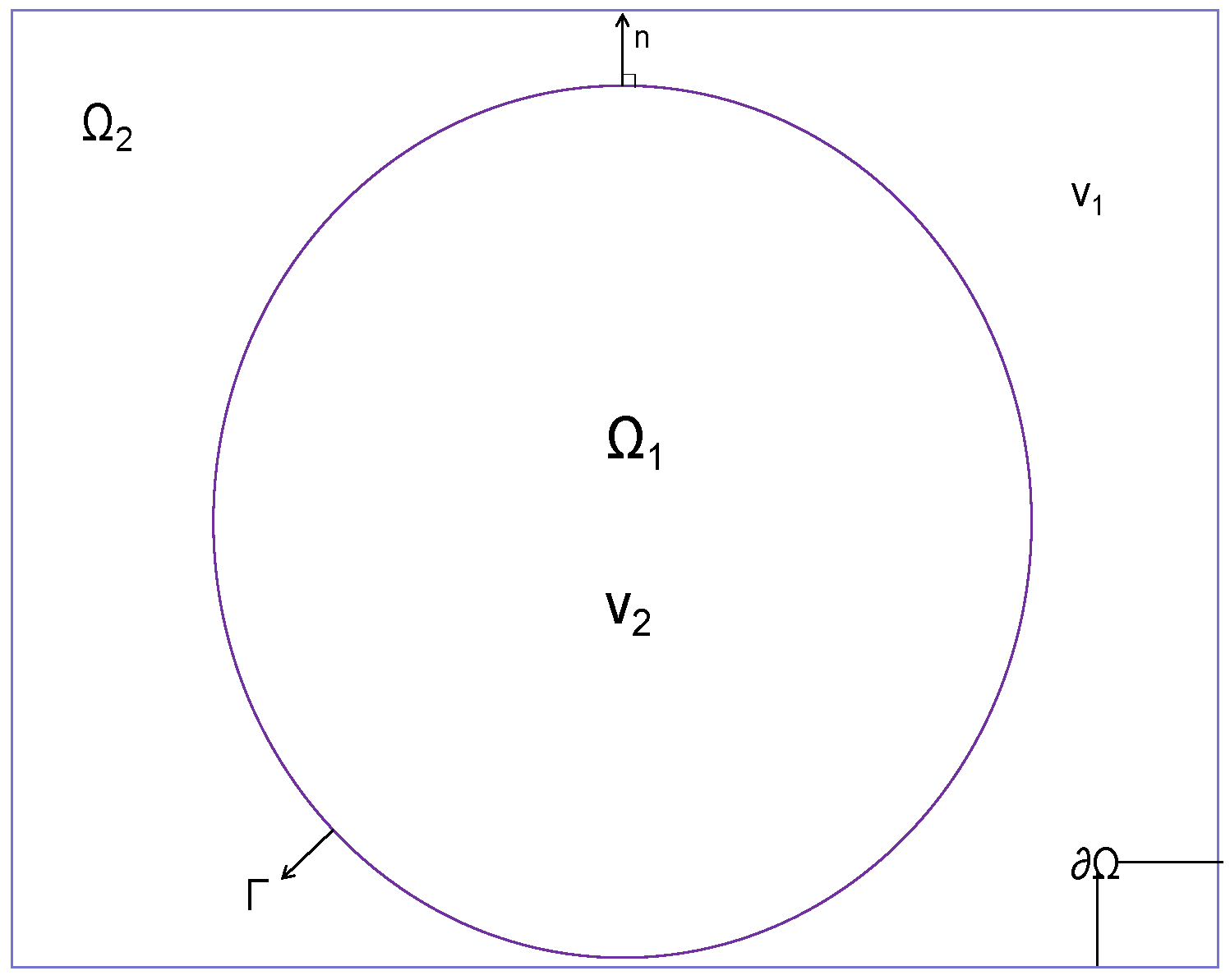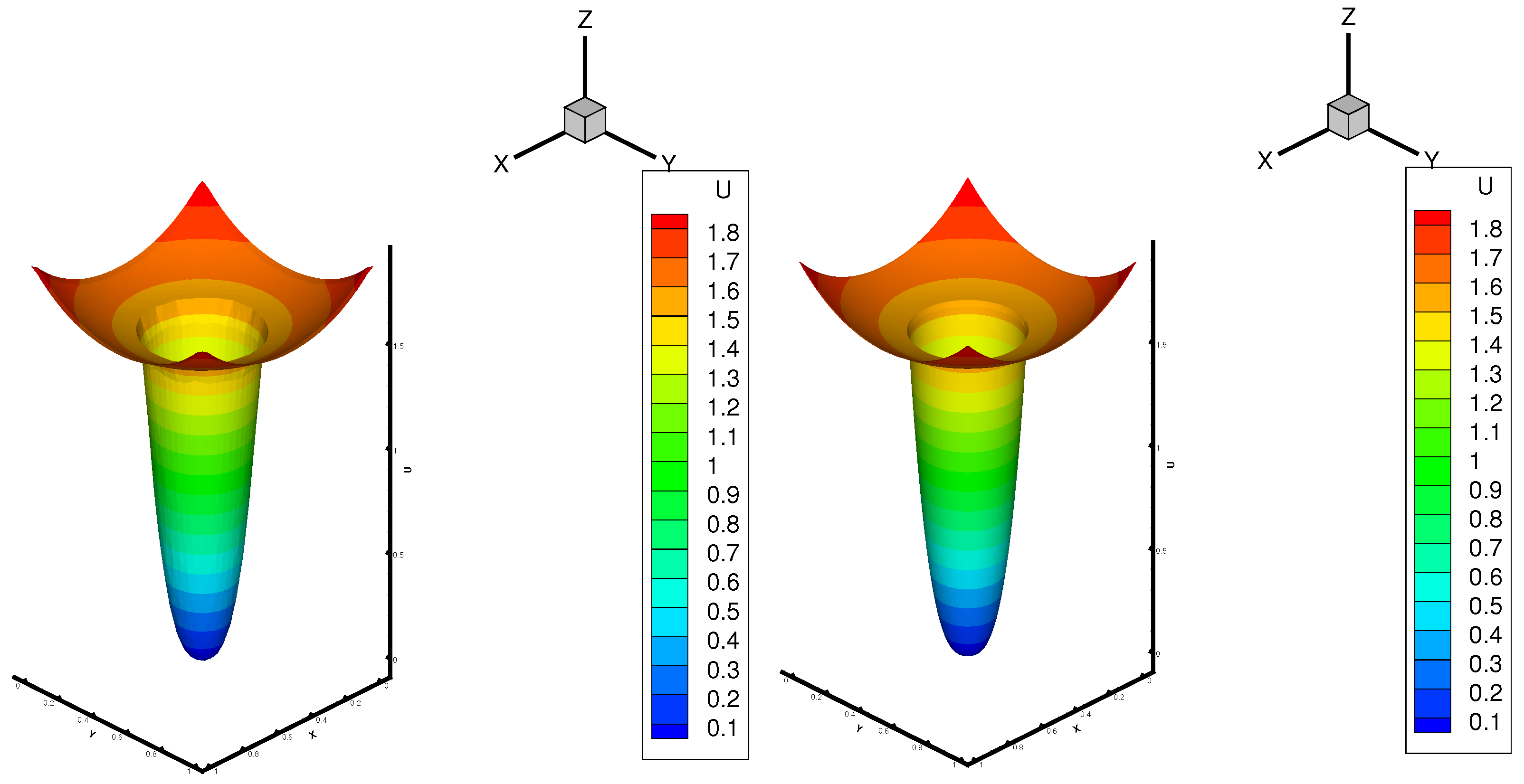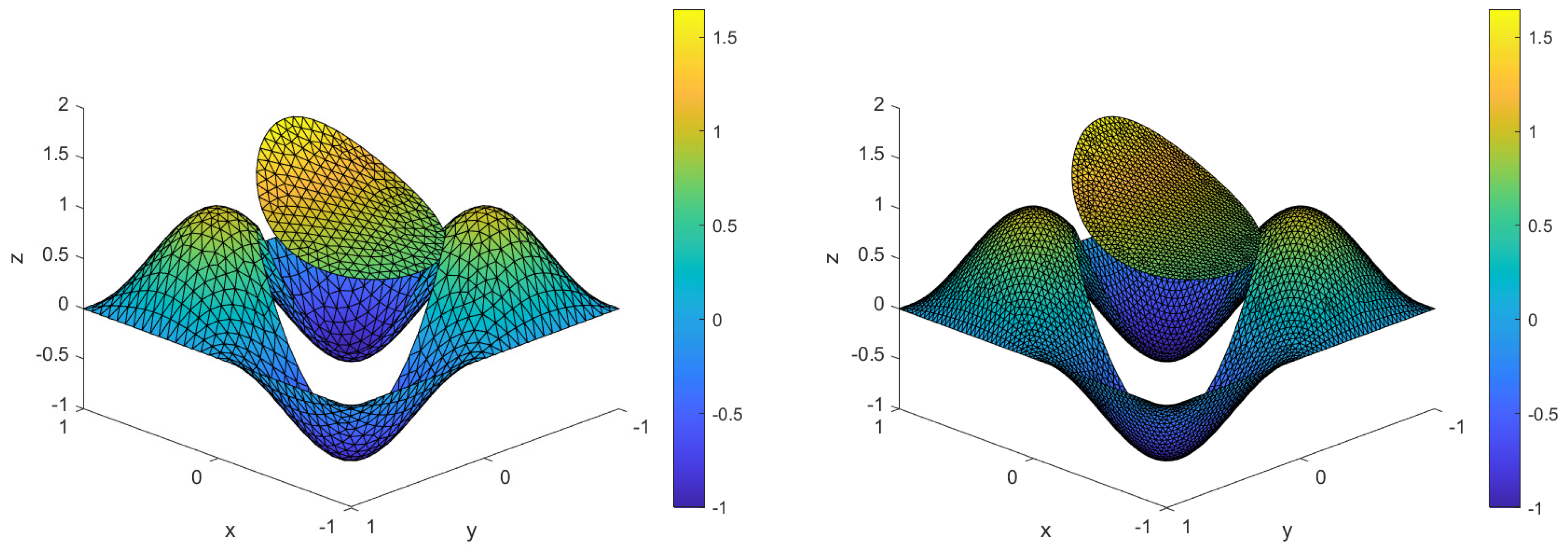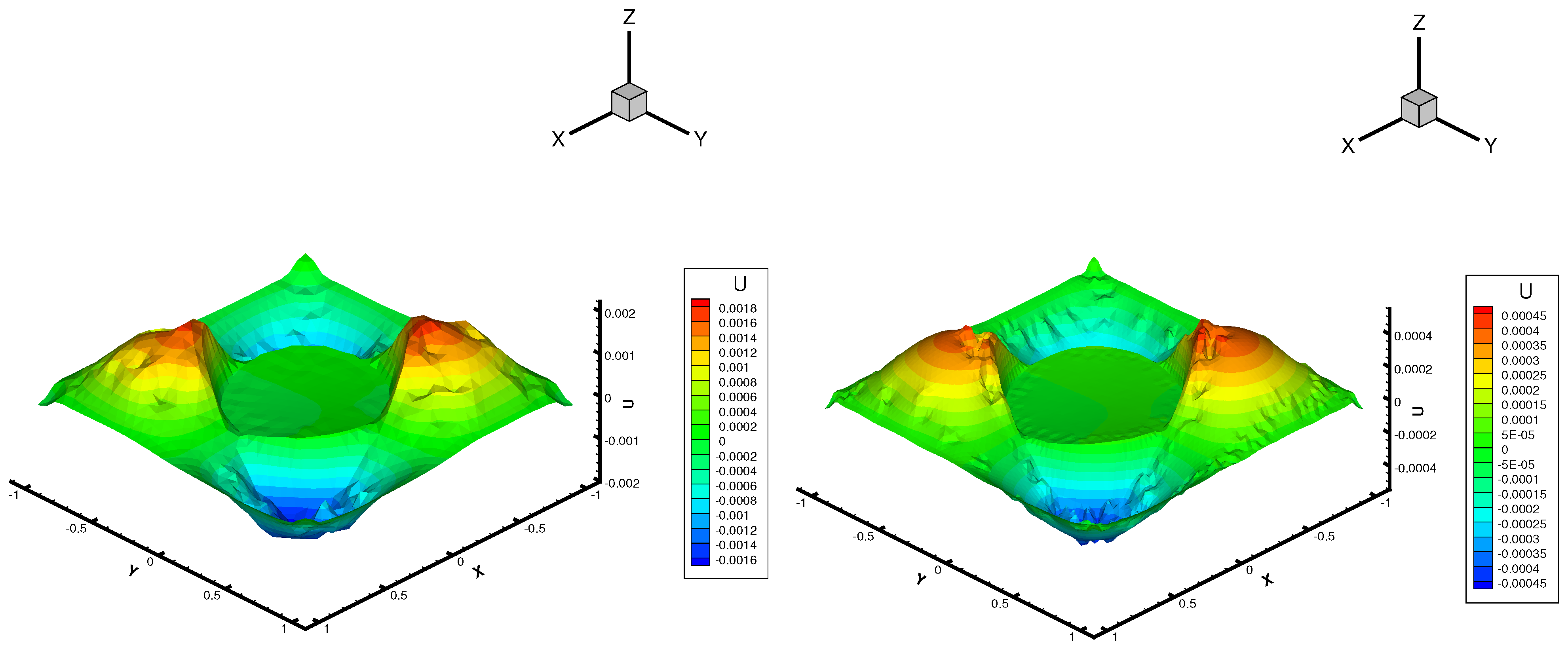Solution of the Elliptic Interface Problem by a Hybrid Mixed Finite Element Method
Abstract
1. Introduction
2. Symbolic Description
3. Hybrid Mixed Finite Element Method
3.1. The Weak Formulation
3.2. The Construction of Local Stiffness Matrix
- Case 1. RT0 element
- Case 2. RT1 element
4. Numerical Examples
- Example 1. (Discontinuous coefficient problem)
- Example 2. (Interface Problem).
- Example 3.
5. Conclusions
- (1)
- The matrix of the linear system of equations in the HMFE format is symmetric positive definite, thus enabling the application of the conjugate gradient method to solve the system of equations. Compared to LDG and HDG methods, the HMFE method does not require the introduction of numerical fluxes and stabilization parameters, making its formulation more concise. Through comprehensive numerical examples, the effectiveness and convergence of the HMFE method are validated.
- (2)
- The proposed hybrid mixed finite element (HMFE) method achieves second-order accuracy and the convergence orders for the gradient term are order 1 and 1.5 with RT0 and RT1 elements, providing significant improvements over first-order methods. Detailed error analysis shows optimal order convergence for both the solution and its gradient, crucial for applications needing precise gradient computations.
- (3)
- Low-order terms and jump conditions are introduced. The inclusion of low-order terms and the enforcement of jump conditions play a critical role in accurately capturing the physical behavior at interfaces. These elements ensure the solution and its flux meet the necessary discontinuities, effectively representing phenomena like sources or sinks and enhancing the method’s overall accuracy and applicability in complex interface problems.
Author Contributions
Funding
Data Availability Statement
Conflicts of Interest
References
- Leveque, R.J.; Li, Z. The immersed interface method for elliptic equations with discontinuous coefficients and singular sources. Siam J. Numer. Anal. 1994, 31, 1019–1044. [Google Scholar] [CrossRef]
- Qin, Q.; Song, L.; Wang, Q. High-order meshless method based on the generalized finite difference method for 2D and 3D elliptic interface problems. Appl. Math. Lett. 2023, 137, 108479. [Google Scholar] [CrossRef]
- Li, D.Y.; Dong, S.Q. Segment explicit-implicit schemes for a parabolic equation with discontinuous coefficients. Math. Numer. Sin. 1997, 19, 193–204. [Google Scholar]
- Wang, Q.; Zhang, Z.; Wang, L. New immersed finite volume element method for elliptic interface problems with non-homogeneous jump conditions. J. Comput. Phys. 2021, 427, 110075. [Google Scholar] [CrossRef]
- Vieira, L.M.; Giacomini, M.; Sevilla, R.; Huerta, A. A second-order face-centred finite volume method for elliptic problems. Comput. Methods Appl. Mech. Eng. 2020, 358, 112655. [Google Scholar] [CrossRef]
- Chen, Y.; Li, Q.; Wang, Y.; Huang, Y. Two-grid methods of finite element solutions for semi-linear elliptic interface problems. Numer. Algorithms 2020, 84, 307–330. [Google Scholar] [CrossRef]
- Guo, R.; Lin, T. An immersed finite element method for elliptic interface problems in three dimensions. J. Comput. Phys. 2020, 414, 109478. [Google Scholar] [CrossRef]
- Lin, T.; Sheen, D.; Zhang, X. A nonconforming immersed finite element method for elliptic interface problems. J. Sci. Comput. 2019, 79, 442–463. [Google Scholar] [CrossRef]
- Zhuang, Q.; Guo, R. High degree discontinuous Petrov–Galerkin immersed finite element methods using fictitious elements for elliptic interface problems. J. Comput. Appl. Math. 2019, 362, 560–573. [Google Scholar] [CrossRef]
- Zhu, J.; Poblete, H.A.V. Robust And Efficient Mixed Hybrid Discontinuous Finite Element Methods for Elliptic Interface Problems. Int. J. Numer. Anal. Model. 2019, 16, 767–788. [Google Scholar]
- Guyomarc’h, G.; Lee, C.O.; Jeon, K. A discontinuous Galerkin methods for elliptic interface problems with application to electroporation. Commun. Numer. Methods Eng. 2009, 25, 991–1008. [Google Scholar] [CrossRef]
- Huynh, L.N.T.; Nguyen, N.C.; Peraire, J.; Khoo, B.C. A high-order hybridizable discontinuous Galerkin method for elliptic interface problems. Int. J. Numer. Meth. Eng. 2013, 93, 183–200. [Google Scholar] [CrossRef]
- Cockburn, B.; Gopalakrishnan, J. A chracterization of hybridized mixed methods for second order elliptic problems. SIAM J. Numer. Anal. 2005, 42, 283–301. [Google Scholar] [CrossRef]
- Boffi, D.; Brezzi, F.; Fortin, M. Mixed Finite Element Methods and Applications; Springer: Heidelberg/Berlin, Germany, 2013. [Google Scholar]
- Bahriawati, C.; Carstensen, C. Three MATLAB implementations of the lowest-order Raviart-Thomas MFEM with a posteriori error control. Comput. Methods Appl. Math. 2005, 5, 333–361. [Google Scholar] [CrossRef]






| Diffusion Coefficient | Number of Elements | Convergence Order | Convergence Order | ||
|---|---|---|---|---|---|
| 2418 | 3.01 × 10 | - | 1.68 × 10 | - | |
| 9556 | 1.53 × 10 | 0.98 | 4.16 × 10 | 1.01 | |
| 37,952 | 7.72 × 10 | 0.99 | 1.10 × 10 | 1.00 |
| Diffusion Coefficient | Number of Elements | Convergence Order | Convergence Order | ||
|---|---|---|---|---|---|
| 2418 | 2.82 × 10 | - | 7.83 × 10 | - | |
| 9556 | 7.05 × 10 | 1.99 | 2.76 × 10 | 1.54 | |
| 37,952 | 1.76 × 10 | 1.99 | 9.72 × 10 | 1.52 |
| Number of Elements | Convergence Order | Convergence Order | ||
|---|---|---|---|---|
| 2418 | 5.21 × 10 | - | 2.19 × 10 | - |
| 9556 | 2.60 × 10 | 1.00 | 1.10 × 10 | 1.00 |
| 37,952 | 1.30 × 10 | 1.00 | 5.49 × 10 | 1.00 |
| Number of Elements | Convergence Order | Convergence Order | ||
|---|---|---|---|---|
| 2418 | 1.62 × 10 | - | 1.48 × 10 | - |
| 9556 | 3.88 × 10 | 2.06 | 5.08 × 10 | 1.54 |
| 37,952 | 9.64 × 10 | 2.00 | 1.77 × 10 | 1.52 |
Disclaimer/Publisher’s Note: The statements, opinions and data contained in all publications are solely those of the individual author(s) and contributor(s) and not of MDPI and/or the editor(s). MDPI and/or the editor(s) disclaim responsibility for any injury to people or property resulting from any ideas, methods, instructions or products referred to in the content. |
© 2024 by the authors. Licensee MDPI, Basel, Switzerland. This article is an open access article distributed under the terms and conditions of the Creative Commons Attribution (CC BY) license (https://creativecommons.org/licenses/by/4.0/).
Share and Cite
Wang, Y.; Wang, P.; Zhang, R.; Liu, J. Solution of the Elliptic Interface Problem by a Hybrid Mixed Finite Element Method. Mathematics 2024, 12, 1892. https://doi.org/10.3390/math12121892
Wang Y, Wang P, Zhang R, Liu J. Solution of the Elliptic Interface Problem by a Hybrid Mixed Finite Element Method. Mathematics. 2024; 12(12):1892. https://doi.org/10.3390/math12121892
Chicago/Turabian StyleWang, Yuhan, Peiyao Wang, Rongpei Zhang, and Jia Liu. 2024. "Solution of the Elliptic Interface Problem by a Hybrid Mixed Finite Element Method" Mathematics 12, no. 12: 1892. https://doi.org/10.3390/math12121892
APA StyleWang, Y., Wang, P., Zhang, R., & Liu, J. (2024). Solution of the Elliptic Interface Problem by a Hybrid Mixed Finite Element Method. Mathematics, 12(12), 1892. https://doi.org/10.3390/math12121892





